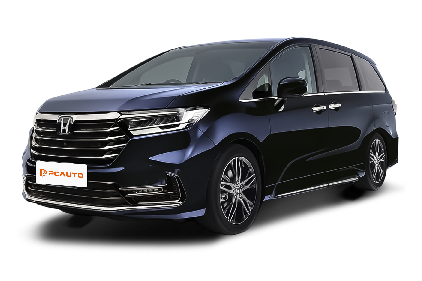Q
Where is Honda Odyssey made?
Honda Odyssey is manufactured in Japan. Honda, a well - known global automaker, was founded in Hamamatsu, Shizuoka Prefecture, Japan in 1948. The Odyssey is a popular mid - to full - size MPV. It originated in Japan and was first introduced in 1994.
Japanese manufacturing craftsmanship is renowned for its precision and high - quality standards. Honda's advanced production facilities in Japan ensure that every Odyssey vehicle meets strict quality control standards. These factories are equipped with state - of - the - art technology and employ highly skilled workers.
Over the years, although Odyssey also has production bases in other regions to meet the needs of the global market, production in Japan remains crucial for maintaining the brand's reputation for reliability, performance, and advanced engineering. The legacy of Japanese craftsmanship is clearly evident in features such as the Odyssey's smoothly - running engine, well - tuned suspension, and luxury interior.
Special Disclaimer: This content is published by users and does not represent the views or position of PCauto.
Related Q&A
Q
Is the 2018 Honda Odyssey reliable?
In 2018, the Honda Odyssey gained popularity among many family users in the Malaysian market for its reliability and practicality. This MPV is equipped with a 2.4-liter i-VTEC engine, which provides smooth power output and good fuel economy, making it suitable for long-distance driving and city commuting. Its Earth Dreams technology also enhances the overall efficiency. In terms of the transmission, it uses a CVT continuously variable transmission, which offers smooth gear shifts and has a relatively low failure rate.
The interior space is spacious. In particular, the flexible seat layout and abundant storage designs are very suitable for family use. In terms of safety, it is equipped with the Honda SENSING system, which includes active safety features such as collision mitigation braking and lane-keeping assist, thus improving driving safety. However, some owners have reported that the third-row seats are of average comfort during long trips, and due to the large body size, drivers need some time to get used to driving it on narrow roads.
Overall, the 2018 Odyssey is a worthy MPV, especially outstanding in terms of space and reliability. If you need a vehicle suitable for family outings, it can be added to your list of options. Of course, when buying a used car, it is recommended to check the maintenance records and conduct a professional inspection to ensure the vehicle is in good condition.
Q
What is the maintenance schedule for a Honda Odyssey 2018?
The 2018 Honda Odyssey in Malaysia is recommended to have regular maintenance every 6 months or every 10,000 kilometers, whichever comes first. Basic maintenance includes changing the engine oil and oil filter, checking tire pressure, the braking system, lights, and chassis components. The air filter and air - conditioning filter need to be replaced every 20,000 kilometers. It is recommended to change the brake fluid and transmission fluid every 40,000 kilometers, and at the same time, check the drive belt and spark plugs. The coolant needs to be replaced every 60,000 kilometers.
Given the hot and humid climate in Malaysia, it is advisable to shorten the replacement cycle of the air - conditioning filter to ensure the cooling effect. Additionally, it's also important to regularly check the battery status and wiper blades, as high temperatures can accelerate the aging of these components. Following the official maintenance plan can not only maintain the vehicle's performance but also extend its service life.
It should be noted that if the vehicle is often driven in congested traffic or harsh environments, you may consider advancing the maintenance interval appropriately. The specific maintenance items may vary depending on the actual usage of the vehicle. It is recommended that car owners refer to the vehicle's manual or consult the local authorized dealer for personalized advice.
Q
How often should I change the oil in my 2018 Honda Odyssey?
Regarding the oil change frequency for the 2018 Honda Odyssey, it is recommended to follow the standard of changing the oil every 5,000 to 8,000 kilometers or every six months. The specific interval depends on your driving conditions. If you often drive short distances in the hot climate of Malaysia or encounter traffic jams, it is advisable to opt for the shorter interval of 5,000 kilometers. On the other hand, if you do a lot of highway driving, you can extend the interval to 8,000 kilometers.
Honda's original recommendation is to use fully synthetic oil with a viscosity of 0W - 20 or 5W - 30. These two types of oil perform stably in high - temperature environments and can better protect the engine. It's worth noting that regular oil changes not only keep the engine running smoothly but also improve fuel economy. It is recommended to check the oil filter every time you change the oil to ensure its filtering effect.
If you are using Honda's maintenance reminder system, you can also perform maintenance according to the system's prompts. However, it should be noted that this system calculates based on normal driving conditions. If your driving environment is relatively harsh, it is recommended to perform maintenance a bit earlier.
In addition, it is also necessary to regularly check the oil level and quality. If you notice that the oil has turned black or its viscosity has decreased, you should consider changing the oil even if the maintenance period has not arrived.
Q
When to change timing belt on 2018 Honda Odyssey?
According to general maintenance guidelines for vehicles with timing belts, it is commonly recommended to replace the timing belt of the 2018 Honda Odyssey every 60,000 to 80,000 kilometers or every 3 to 5 years, whichever occurs first. The hot and humid climate in Malaysia may accelerate the aging of rubber components, so owners are advised to have the timing belt inspected more frequently under these conditions.
The timing belt is a critical engine component. Its failure can lead to piston-to-valve interference, potentially causing catastrophic engine failure and expensive repairs. In addition to the timing belt, it is highly recommended to replace related components like the water pump, tensioner, and idler pulleys concurrently. Since these parts usually can only be accessed after removing the timing belt, replacing them all at once can save subsequent labor costs.
Car owners in Malaysia should also pay attention to using original or replacement parts of equivalent quality to ensure durability and choose a repair shop with experience in servicing Honda models for the operation. Because the transverse V6 engine of the Odyssey has a relatively compact structure, professional tools and techniques are required.
If high-pitched chirping or squealing noises emanate from the engine bay, or if cracks, fraying, or missing teeth on the belt are visible, an immediate inspection is imperative. Such signs often indicate that the belt is worn.
Q
Is the 2018 Honda Odyssey 2wd or 4wd?
The 2018 Honda Odyssey available in the Malaysian market is mainly the front - wheel drive (2WD) version, and the four - wheel drive (4WD) configuration was not introduced. This model is equipped with a 2.4 - liter i - VTEC naturally aspirated engine, paired with a CVT transmission. It focuses on comfort and family practicality. Its space layout and intelligent features are well - suited for the long - distance travel needs of Malaysian families.
In Malaysia, front - wheel drive vehicles have become the mainstream choice for most MPV models because of their simple structure, lower fuel consumption, and more cost - effective maintenance. On the other hand, four - wheel drive versions are generally more suitable for regions that require higher off - road performance or face complex road conditions. However, as an urban family car, the front - wheel drive design of the Odyssey can fully meet daily use.
For consumers considering an MPV, besides the drive type, they can also pay attention to the highlights of the Odyssey, such as the Honda Sensing safety system and the flexible seat layout. At the same time, it is recommended to compare the drive configurations and functional differences with peer models like the Toyota Alphard according to actual needs to make a more appropriate choice.
Q
Is a 2018 Honda Odyssey a good car?
The 2018 Honda Odyssey is a seven - seat MPV that has performed well in the Malaysian market. It's a great fit for families. It comes with the Honda Sensing safety system, including features like adaptive cruise control and lane - keeping assist, enhancing driving safety.
The interior space is spacious. The third - row seats can be flexibly folded, offering excellent storage capacity, making it ideal for long - distance trips. However, its chassis tuning leans towards comfort, so its handling isn't as good as that of sporty models. Also, the maintenance cost is slightly higher than that of locally assembled vehicles.
If you're looking for a reliable family car, the 2018 Odyssey is worth considering. But it's recommended to check the condition of used cars and confirm the original factory warranty status before purchasing. Additionally, there's a high demand for MPVs in the Malaysian market. Similar models include the Toyota Innova and Nissan Serena. You can compare the configurations and space performance according to your budget and needs.
Q
How often should the transmission fluid be changed in a 2018 Honda Odyssey?
According to Honda's official recommendation, the transmission fluid replacement interval for the 2018 Honda Odyssey is typically every 40,000 to 60,000 kilometers or every 2 to 3 years. The specific interval depends on driving conditions. If you often drive short distances frequently in Malaysia's hot climate, tow heavy loads, or get stuck in long - term traffic jams, it is recommended to shorten the replacement interval to 40,000 kilometers to ensure the smooth operation of the transmission and extend its service life.
Transmission fluid is a crucial medium for power transmission and lubrication. After it ages, it can cause rough shifting, increased fuel consumption, and even component wear. In particular, the Earth Dreams technology transmission used in the Honda Odyssey has relatively high requirements for the cleanliness of the oil. Owners in Malaysia should also pay attention to using the ATF DW - 1 type of oil specified by the original factory and avoid mixing different specifications of products. At the same time, regularly check the color of the oil (normally it should be a clear red; if it darkens or becomes cloudy, it needs to be replaced immediately). And adjust the maintenance plan according to the "Severe Driving Conditions" clause in the maintenance manual. For example, the hot and humid Southeast Asian environment all year round may be classified as severe working conditions.
In addition, although some new - type transmissions claim to be "maintenance - free", regularly replacing the oil is still the most cost - effective way to prevent major overhauls, which is especially important for 7 - seat MPVs that are often fully loaded.
Q
Does a 2018 Honda Odyssey have a timing chain or timing belt?
In 2018, the Honda Odyssey was equipped with a timing chain rather than a timing belt. This model features a 3.5 - liter V6 i - VTEC engine. The timing system of this engine uses a chain design, which is more durable compared to a belt. Usually, it doesn't need to be replaced regularly like a timing belt. You just need to check its condition during regular maintenance.
For Malaysian car owners, the advantage of the timing chain lies in its lower maintenance cost. Especially in the hot and humid climate, the metal material of the chain is more resistant to aging than the rubber belt, making it suitable for long - term use.
However, although the timing chain has a long service life, it is still recommended that car owners follow the original manufacturer's maintenance manual and regularly check the engine oil condition. Insufficient oil lubrication may affect the chain's lifespan. In addition, if you hear abnormal metallic noises in the engine compartment, it may indicate that the chain or the tensioner needs to be inspected. Timely repairs can prevent greater damage.
Understanding the type of the timing system and the key points of maintenance can help car owners better maintain their vehicles and ensure the long - term stable operation of the engine.
Q
What is the fuel pump recall on 2018 Odyssey?
Honda Odyssey initiated a global recall due to fuel pump malfunctions. Some vehicles in the Malaysian market might also be affected. The problem stems from the possible deformation of the impeller inside the fuel pump due to manufacturing defects, which could cause the engine to suddenly stall while driving, posing a safety hazard. Subsequently, Honda Malaysia replaced the improved fuel pump assemblies for the affected vehicles free of charge through authorized dealers.
As the core component of the fuel supply system of an EFI engine, the reliability of the fuel pump directly affects driving safety. It is recommended that owners of the 2018 Odyssey continuously follow the recall announcements on the official website of Honda Malaysia or use the VIN code query tool to confirm whether their vehicles are on the list. If they notice symptoms such as weak acceleration, unstable idling, or abnormal stalling, they should immediately contact the dealer for inspection.
It's worth noting that fuel system maintenance is particularly important in Malaysia's tropical climate. Regularly replacing the fuel filter and using gasoline that meets the standards can effectively extend the lifespan of the fuel pump. If the owner has modified the fuel system or installed external devices on their own, it may affect the effectiveness of the original - factory recall service. It is advisable to inform the service center in advance to ensure the maintenance rights.
Q
Does the 2018 Honda Odyssey have all wheel drive?
The 2018 Honda Odyssey doesn't offer an all - wheel drive (AWD) version in the Malaysian market. This model is only equipped with a front - wheel drive (FWD) system. This design mainly focuses on fuel economy and ride comfort for city driving, making it suitable for daily use by family users.
An all - wheel drive system is generally more suitable for areas that need to deal with complex road conditions or adverse weather. However, the climate and road conditions in Malaysia are relatively stable, and front - wheel drive can meet most needs. If you have a particular preference for all - wheel drive, you can consider other brands or models. But note that all - wheel drive may increase the purchase cost and fuel consumption.
The advantages of the Honda Odyssey lie in its spacious interior, flexible seat layout, and reliable power performance. These features make it one of the popular choices for family cars in Malaysia.
Latest Q&A
Q
How much is a Nissan 2018 worth?
The used car prices for 2018 Nissan models in Malaysia vary depending on the model, condition, mileage, and specifications. Generally, the price range is between RM60,000 and RM120,000. For example, the entry-level Nissan Almera might cost between RM60,000 and RM80,000, while higher-spec Nissan X-Trail or Nissan Teana could go up to RM100,000 to RM120,000. Used car prices are also influenced by market demand, maintenance records, and vehicle color. It's advisable to check specific quotes through used car platforms or dealers before purchasing and arrange a professional inspection to ensure the vehicle is in good condition. Additionally, Nissan models are known in Malaysia for their durability and low maintenance costs, especially the Almera and X-Trail, which have a high local ownership rate, ensuring ample parts supply and relatively convenient repairs. If considering financing a used car purchase, it's important to note banks' restrictions on vehicle age and mileage; typically, vehicles over 10 years old or with high mileage will have stricter loan conditions.
Q
How much is a 2018 Nissan Navara?
Prices for the 2018 Nissan Navara in Malaysia's used car market typically range from RM70,000 to RM120,000, depending on condition, mileage, trim level, and location. High-spec VL or V variants usually command a RM20,000 to RM30,000 premium over base E or S models. This pickup truck is known for its 2.5-liter turbo diesel engine (190hp/450Nm) and robust chassis, making it well-suited to local road conditions—especially popular with construction and agricultural users. Its 7.3-meter minimum turning radius and 216mm ground clearance perform exceptionally well across Southeast Asia's varied terrains. Notably, the Navara's used prices sit slightly below the 2018 Toyota Hilux or Mitsubishi Triton, but it offers more affordable maintenance costs. An unexpired original 5-year/150,000km warranty (whichever comes first) can boost resale value. Buyers should verify 4WD system and transmission condition through PUSPAKOM inspection, while checking the ETEMS system to ensure no outstanding road tax or fines.
Q
What is the best selling Nissan in 2023?
The best-selling Nissan model in the Malaysian market for 2023 was the Nissan Almera. This B-segment sedan emerged as a popular pick among local buyers thanks to its budget-friendly price tag, impressive fuel efficiency, and practical features that cater perfectly to young families. Under the hood, the Almera packs a 1.0-liter turbocharged engine, churning out 122 horsepower and 152 Nm of torque, paired with a CVT gearbox. It strikes a nice balance between power and fuel economy, making it especially well-suited for Malaysia's urban driving conditions. The car also comes loaded with Nissan Intelligent Mobility safety tech, including a 360-degree around-view monitor and an intelligent forward collision warning system. It's worth highlighting that Malaysian consumers hold the Nissan brand in high regard, particularly for its reliable durability and extensive after-sales service network, which has helped Nissan maintain steady performance in the local market. Beyond the Almera, the Nissan Navara pickup truck and X-Trail SUV also enjoy considerable popularity, showcasing the brand's competitiveness across different market segments. With the growing trend towards new energy vehicles, Nissan is also gradually introducing its e-POWER hybrid technology in Malaysia, potentially offering consumers more diverse powertrain options in the future.
Q
What is the cheapest Nissan car in 2023?
The cheapest Nissan model in Malaysia for 2023 is the Nissan Almera. This entry-level four-door sedan has become a hit with budget-conscious buyers thanks to its affordable price tag and practical features. Its 1.0-liter turbocharged engine delivers excellent fuel efficiency, making it perfect for city driving, while standard tech like smart keyless entry and a 7-inch touchscreen add to its strong value proposition. When factoring in running costs, the Almera also boasts relatively low maintenance expenses, aligning with Malaysian consumers' demand for economical vehicles. On top of that, Nissan's well-established dealer network and convenient after-sales support in Malaysia provide extra peace of mind for owners. For buyers on a tight budget who still want brand reliability, the Almera is definitely worth considering. That said, rivals in the same segment like the Toyota Vios and Honda City each have their own strengths, so it's advisable for consumers to test drive and compare based on their personal needs before making a final decision.
Q
How much is Nissan Almera turbo 2023 in the Philippines?
The 2023 Nissan Almera Turbo is priced at around 848,000 Philippine pesos (approximately RM70,000, with exchange rates subject to fluctuation) in the Philippine market. This is the entry-level price for the 1.0-liter turbocharged variant, and higher-spec models will cost more accordingly. Under the hood, it packs a 1.0T three-cylinder turbo engine that cranks out 100 horsepower and 152 Nm of torque, paired with a CVT transmission. Fuel efficiency is a key selling point here, with an official rating of 23.3km/L. For Malaysian consumers, the Almera Turbo sits in a similar segment as local B-segment sedans like the Proton Saga and Perodua Bezza, but its turbocharged powerplant gives it a unique edge. It's worth noting that the Philippine-spec Almera Turbo might have slightly different features compared to the Malaysian version (locally known as the Nissan Almera). For instance, the smart key system that comes standard in the Philippines could be an optional extra in Malaysia. Additionally, the automotive tax structure in the Philippines differs from Malaysia, which affects the final selling price. If Malaysian buyers are considering parallel imports, they'll also need to factor in extra costs like import duties and AP permits, which typically make the car significantly more expensive than models from official local channels.
View MoreRelated News

Honda N-ONE e: Officially launched in the Japanese market, with a range of 295 kilometers
AshleySep 12, 2025

Honda Prelude returns after 24 years, the sixth-generation Prelude will be released in Japan
Kevin WongSep 4, 2025

Honda S7 and P7 sales in China fall short of expectations, significantly lagging behind Toyota and Nissan.
RobertSep 4, 2025

The 2025 Honda Prelude Is Back: Hybrid-Powered Coupe with Type R Chassis Tech
JohnAug 4, 2025

Honda Chief Engineer Goes Viral for Hairstyle, Formerly Led EV Dynamic Tuning
RobertJul 31, 2025
View More













 Cars
Cars




Pros
Cons